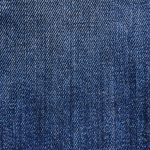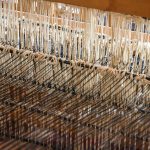To stay cool all night, choose pillowcases made from breathable, moisture-wicking fabrics like cotton, bamboo, or linen. These natural materials regulate temperature and pull sweat away from your skin, keeping you dry and comfortable. Performance blends with moisture-wicking tech also do a great job at enhancing airflow and preventing overheating. Pay attention to weave and thread count, too—they affect breathability. If you want to discover which fabrics and care tips make the biggest difference, there’s plenty more to explore.
Table of Contents
Key Takeaways
- Choose breathable fabrics like cotton, bamboo, or linen for optimal airflow and moisture absorption to keep pillowcases cool all night.
- Performance fabrics with moisture-wicking technology, such as polyester blends and bamboo, efficiently pull sweat away to maintain dryness and comfort.
- Percale weave pillowcases with moderate thread counts (200-400) promote better airflow and temperature regulation compared to denser sateen weaves.
- Bamboo and Tencel fabrics offer hypoallergenic properties and softness that enhance comfort for sensitive skin while staying cool.
- Proper care, including gentle washing with cold water and avoiding fabric softeners, helps preserve the cooling properties of pillowcases.
Understanding the Importance of Cooling Fabrics in Pillowcases
Although many people overlook the fabric of their pillowcases, choosing cooling materials can dramatically improve your sleep quality. When you pick the right fabric, it helps regulate your body temperature throughout the night, preventing overheating and discomfort.
You’ll notice fewer night sweats and wake up feeling refreshed instead of restless. Cooling fabrics wick moisture away, keeping your skin dry and comfortable. They also promote better airflow, which helps maintain a consistent, cool surface against your skin.
How Cooling Fabrics Enhance Sleep Quality
When you use cooling fabrics for your pillowcases, you help your body maintain an ideal temperature throughout the night. This temperature regulation prevents overheating, which often disrupts your sleep cycle.
By staying cool, you fall asleep faster and experience fewer awakenings, allowing your body to complete essential restorative processes. Cooling fabrics also wick away moisture, keeping your skin dry and comfortable, which reduces irritation and discomfort.
Staying cool helps you fall asleep faster and stay comfortable by wicking away moisture and reducing irritation.
As a result, you enjoy deeper, more restful sleep. Additionally, these fabrics create a fresh, breathable surface that minimizes night sweats, enhancing overall comfort.
Choosing the right cooling pillowcase supports your natural sleep rhythms, helping you wake up feeling refreshed and alert. Ultimately, cooling fabrics improve your sleep quality by promoting a consistently comfortable environment.
Cotton: A Natural Cooling Fabric Option
You’ll appreciate how cotton’s breathability and moisture absorption keep you cool and dry through the night.
Its softness adds comfort, making your pillowcase feel gentle against your skin.
Plus, cotton is durable and easy to care for, so it stands up to regular use without losing its cooling qualities.
Breathability and Moisture Absorption
Since staying cool and dry is key to a good night’s sleep, choosing pillow cases made from breathable fabrics like cotton can make a big difference.
Cotton’s natural fibers allow air to circulate freely, helping you avoid overheating. Plus, cotton absorbs moisture efficiently, keeping sweat away from your skin. This combination guarantees you stay comfortable throughout the night.
Here’s why cotton excels in breathability and moisture absorption:
- Its porous fibers promote airflow, reducing heat buildup.
- Cotton absorbs moisture up to 27 times its weight, keeping you dry.
- It dries quickly, preventing dampness and discomfort.
- The fabric’s breathability minimizes the risk of bacterial growth caused by trapped sweat.
Choosing cotton pillow cases helps you stay cool and fresh all night long.
Softness and Comfort Benefits
Beyond breathability and moisture absorption, cotton pillow cases offer exceptional softness that enhances your overall comfort.
When you lay your head down, you’ll immediately notice the gentle, smooth feel against your skin, helping you relax and fall asleep faster.
Cotton’s natural fibers are gentle enough for sensitive skin, reducing irritation and promoting a soothing sleep environment.
Unlike synthetic fabrics, cotton adapts to your body temperature, providing warmth without overheating.
This balance keeps you comfortable throughout the night, whether it’s a cool or warm evening.
Choosing cotton means you’re investing in a pillow case that not only cools but also pampers you with its plush softness.
It’s a simple way to improve your sleep quality every night.
Durability and Easy Care
Although cotton pillow cases deliver softness and breathability, they also stand out for their durability and easy care.
When you choose cotton, you get a fabric that withstands frequent washing without losing its shape or comfort. Plus, cotton handles wear and tear better than many synthetic materials, making it a smart investment for long-term use.
To keep your cotton pillow cases in top shape, follow these tips:
- Wash in cold or warm water to preserve fibers.
- Use mild detergent to avoid fabric damage.
- Tumble dry on low heat or air dry to prevent shrinking.
- Iron on medium heat if you prefer a crisp look.
With minimal effort, you’ll enjoy cotton’s cooling qualities night after night.
Bamboo Fibers for Breathability and Softness
You’ll love how bamboo fibers naturally wick away moisture, keeping you dry throughout the night.
Their hypoallergenic qualities make them perfect if you have sensitive skin.
Plus, the soft texture feels gentle and breathable against your face.
Natural Moisture-Wicking Properties
When you choose pillowcases made from bamboo fibers, you tap into their natural ability to wick moisture away from your skin. This means you stay dry and comfortable, even on warm nights.
Bamboo fibers pull sweat away, allowing it to evaporate quickly, which keeps you cool and prevents that sticky feeling.
Here’s why bamboo’s moisture-wicking properties stand out:
- Bamboo fibers absorb moisture faster than cotton.
- They promote better airflow, enhancing breathability.
- Moisture evaporation happens efficiently, reducing heat buildup.
- You wake up feeling fresh, with less clamminess or dampness.
Hypoallergenic and Gentle Texture
Because bamboo fibers naturally resist allergens and irritants, you can enjoy pillowcases that feel gentle against your skin while promoting breathability.
These fibers create a soft, smooth texture that’s perfect if you have sensitive skin or allergies. You won’t have to worry about itching or irritation disrupting your sleep.
Bamboo’s natural hypoallergenic properties block dust mites and bacteria, making your pillowcase a cleaner, healthier sleeping environment.
Plus, bamboo fabric is highly breathable, so it helps regulate your body temperature by allowing air to flow freely.
This combination of softness, breathability, and allergen resistance means you can stay cool and comfortable all night long without sacrificing skin health.
Choosing bamboo pillowcases is a smart way to enhance your sleep quality naturally.
Linen Pillowcases: Durable and Temperature-Regulating
Linen pillowcases offer a perfect blend of durability and temperature regulation, making them an excellent choice for a restful night’s sleep. You’ll appreciate how linen’s natural fibers wick moisture away, keeping you cool even on warm nights.
Plus, linen gets softer with each wash, enhancing comfort over time. If you’re seeking long-lasting bedding that breathes well, linen is a smart pick.
Here’s why linen pillowcases stand out:
- Strong fibers resist wear and tear, ensuring longevity.
- Breathable weave promotes airflow to prevent overheating.
- Naturally moisture-wicking to keep your skin dry.
- Hypoallergenic properties reduce irritation for sensitive skin.
Choosing linen means you get durable, breathable comfort that helps you stay cool all night.
Tencel and Lyocell: Sustainable and Cooling Choices
If you appreciate linen’s natural breathability and moisture-wicking properties, you’ll find Tencel and Lyocell offer similar benefits with a sustainable edge.
Both fibers come from sustainably harvested eucalyptus trees, processed using eco-friendly methods that minimize chemical use and water waste.
When you sleep on pillowcases made from Tencel or Lyocell, you’ll enjoy a silky-smooth feel that stays cool throughout the night.
These fabrics effectively pull moisture away from your skin, keeping you dry and comfortable.
Plus, their breathable structure promotes airflow, reducing heat buildup.
They resist wrinkles and maintain softness after repeated washes, making them practical and long-lasting choices.
Choosing Tencel or Lyocell means you’re not only enhancing your sleep experience but also supporting environmentally responsible production.
Performance Fabrics With Moisture-Wicking Technology
You’ll notice that performance fabrics with moisture-wicking technology pull sweat away from your skin to keep you dry and cool throughout the night.
Materials like polyester blends and bamboo are popular choices for this purpose.
Using these fabrics in pillowcases can help regulate temperature and improve your overall sleep comfort.
How Moisture-Wicking Works
Because moisture can disrupt your sleep, performance fabrics with moisture-wicking technology work by pulling sweat away from your skin and spreading it across the fabric’s surface. This process keeps you dry and comfortable throughout the night.
Here’s how it works:
- Fibers absorb moisture from your skin quickly.
- Sweat moves through tiny channels in the fabric.
- Moisture spreads evenly over a larger surface area.
- The fabric releases moisture into the air by evaporation.
Top Performance Fabric Types
Performance fabrics with moisture-wicking technology come in several key types, each designed to keep you cool and dry throughout the night.
Polyester is a popular choice because it pulls moisture away from your skin quickly and dries fast.
Nylon offers similar benefits but feels softer against your skin.
Merino wool might surprise you—it’s natural, breathable, and excellent at regulating temperature while wicking moisture.
Bamboo fabric combines softness with natural antibacterial properties and effective moisture management.
Finally, blends that mix these materials often enhance durability and comfort.
When choosing your pillowcase, look for these fabrics to guarantee you stay comfortable, sweat-free, and refreshed all night long.
They actively manage moisture, so you won’t wake up sticky or overheated.
Benefits for Nighttime Cooling
When you sleep on moisture-wicking pillowcases, your skin stays dry and comfortable, preventing that sticky, overheated feeling that disrupts rest.
These performance fabrics pull sweat away from your skin, enhancing airflow and keeping you cooler throughout the night. Here’s why this matters:
- Improved Sleep Quality: Staying dry helps you fall asleep faster and reduces nighttime awakenings.
- Temperature Regulation: Moisture-wicking fabrics balance your body heat, so you don’t overheat or feel too cold.
- Skin Health: By reducing moisture buildup, these fabrics minimize irritation and breakouts.
- Durability and Easy Care: These pillowcases maintain their cooling properties even after multiple washes.
Choosing moisture-wicking pillowcases means you wake up refreshed, not sweaty or uncomfortable.
The Role of Weave and Thread Count in Cooling
Anyone seeking a cooler night’s sleep should understand how weave and thread count affect pillowcase breathability.
The weave refers to how fabric threads intertwine, and it directly impacts airflow. For instance, a percale weave has a tight, plain structure that allows air to pass through easily, keeping you cool. In contrast, sateen weaves feel smoother but trap more heat due to their denser construction.
Thread count, or the number of threads per square inch, also matters but doesn’t always mean better cooling. Extremely high thread counts can reduce breathability by packing fibers too tightly.
Aim for a moderate thread count—typically between 200 and 400—which balances softness with airflow. Understanding these factors helps you pick pillowcases that stay fresh and comfortable through hot nights.
Comparing Synthetic vs. Natural Cooling Fabrics
While the weave and thread count influence how breathable your pillowcase feels, the type of fabric plays an equally important role in keeping you cool.
Synthetic fabrics like polyester wick moisture away quickly but may trap heat, while natural fabrics such as cotton and linen offer better airflow and a softer feel. Choosing between them depends on your preferences for temperature regulation and comfort.
Here’s a quick comparison:
- Moisture management: Synthetics dry faster; naturals absorb moisture.
- Breathability: Naturals allow more air circulation.
- Durability: Synthetics resist wear and wrinkles better.
- Feel: Naturals typically feel softer and more comfortable against skin.
Knowing these differences helps you pick the right cooling fabric for your pillowcase.
Caring for Your Cooling Fabric Pillowcases to Maintain Performance
To keep your cooling fabric pillowcases working their best, you need to handle them with care during washing and drying.
Always follow the care label instructions closely. Use a gentle cycle with cold water to prevent damaging the cooling fibers. Avoid bleach and fabric softeners—they can break down the fabric’s cooling properties. If possible, wash your pillowcases separately to reduce friction and pilling.
When drying, skip the high heat; instead, air dry or tumble dry on low to preserve the fabric’s integrity. Ironing is usually unnecessary and can harm synthetic cooling materials.
Frequently Asked Questions
Can Cooling Pillowcases Help Reduce Acne and Skin Irritation?
Cooling pillowcases can help reduce acne and skin irritation by keeping your skin dry and minimizing sweat buildup. They also prevent friction, which can irritate your skin, so you’ll likely notice a calmer, clearer complexion.
Are Cooling Fabrics Safe for People With Allergies or Sensitive Skin?
Imagine gentle breezes on your skin—cooling fabrics can be safe for allergies or sensitive skin if you choose hypoallergenic, breathable materials like bamboo or silk. You’ll want to avoid synthetic fibers that might irritate you.
How Do Cooling Pillowcases Perform in Humid Climates?
You’ll find cooling pillowcases help wick moisture and improve airflow, but in very humid climates, they might feel less effective. Choosing moisture-wicking, breathable fabrics like bamboo or linen can boost comfort and keep you cooler.
Can Cooling Fabric Pillowcases Be Used With Electric Blankets?
You can use cooling fabric pillowcases with electric blankets, but be cautious. Some fabrics may trap heat or reduce the blanket’s efficiency. Always check care labels and test for comfort to avoid overheating or damage.
Do Cooling Pillowcases Affect the Lifespan of Pillows?
Did you know pillowcases can reduce pillow lifespan by up to 20% if not breathable? Using cooling pillowcases helps wick moisture away, keeping pillows fresher longer, so you won’t have to replace them as often.
- The Difference Between Fiber Reactive and All-Purpose Dyes - July 13, 2025
- How to Create a Rainbow V-Pattern Tie-Dye - July 13, 2025
- Tie-Dye for All Seasons: Holiday-Themed Techniques - July 13, 2025







